Tips for Visiting Yellowstone National Park in June
June in Yellowstone: Visiting Yellowstone in June is a great time to visit the park. Especially if you can visit in early June before the crowds arrive. This guide to Yellowstone National Park in June will help you plan your trip.
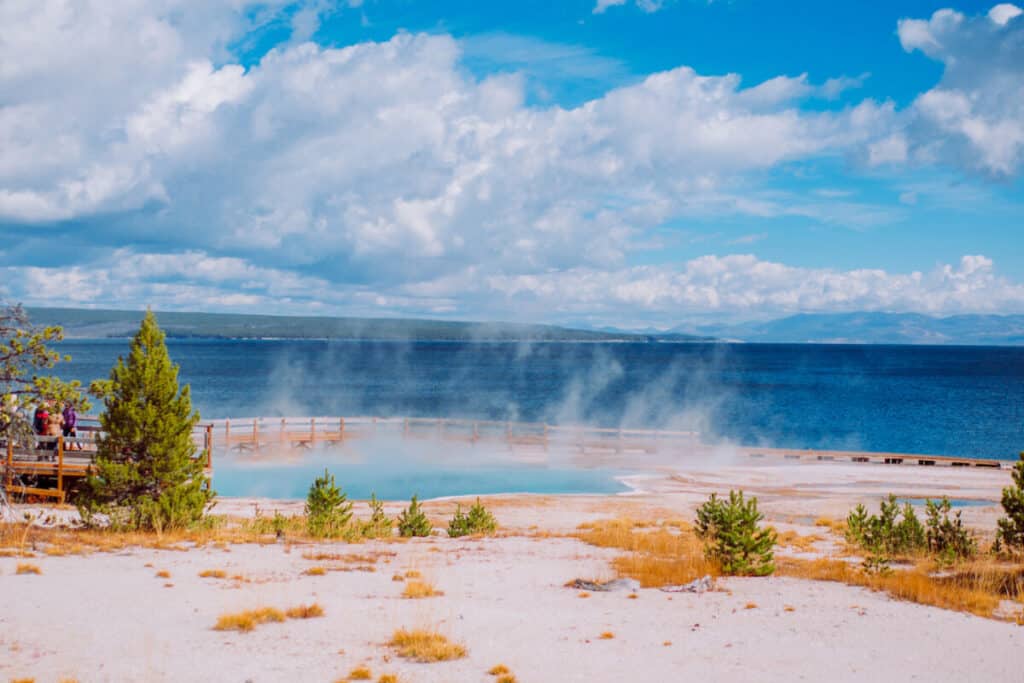
Yellowstone National Park is at its most spectacular in June. With newborn bison and elk calves and blooming wildflowers, the park is bustling with activity.
The wealth of wildlife is the best reason to visit Yellowstone in June. Elk and bison are calving in Mammoth Hot Springs, and bison are calving in Lamar Valley.
It’s a beautiful time of year to see fresh life in the meadows, surrounded by new life in the form of wildflowers.
Another advantage of going in June is that most of the trails are usually open when the snow melts.
Hiking in Yellowstone in June is fantastic and I’ve included quite a few hikes on this list. Walking through a meadow or up a mountain and seeing the snow-capped summits of the high ranges is a magical experience. June is a magical month in Yellowstone.
Thank you for supporting this website written by an American. This post may contain affiliate links. This means I earn a small commission on these links at no extra cost to you.
National Park Entrance Fees
To enter the National Parks, you’ll need to pay an entrance fee or have a National Parks Pass also known as American the Beautiful Pass.
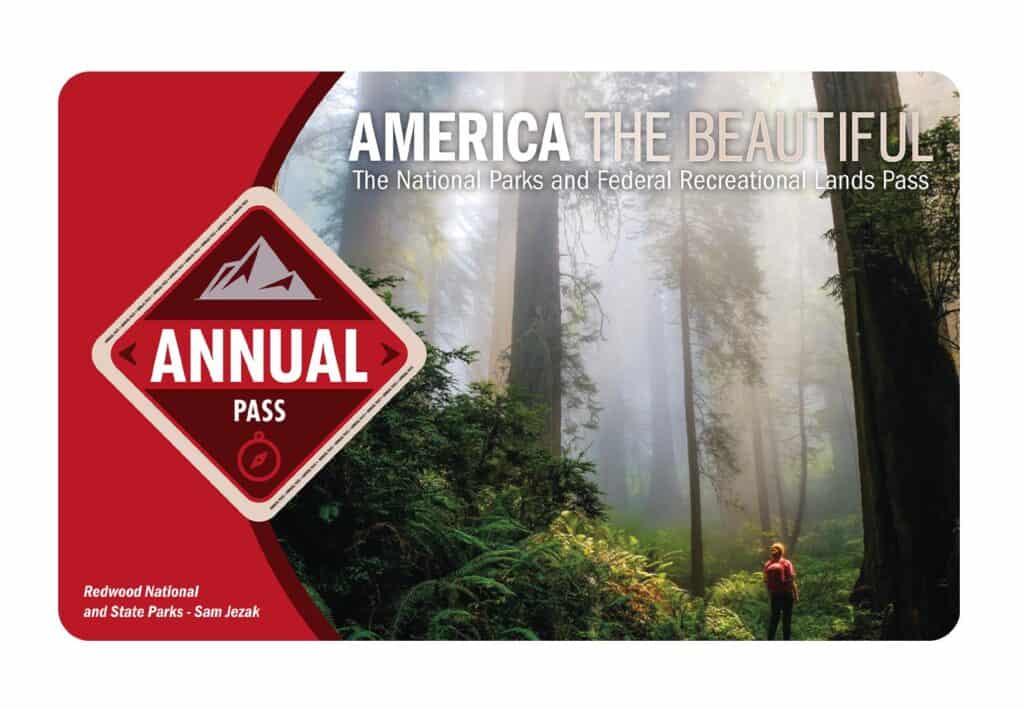
It costs $80 for a yearly America the Beautiful Pass. This gives you access to all national parks and federal areas that charge fees. The America the Beautiful Pass is well worth it!
I purchased my first one in 2016 and it’s such a money-saver! Plus 10% of sale proceeds go to the National Park Foundation.
Tips for Visiting Grand Teton National Park
Grand Canyon National Park is perfect for outdoor enthusiasts. There is something for everyone on this list and for different fitness levels. Also, note that it is dry and hot (in the summer), and make sure you know what you are getting into before you start. Here are a few tips for visiting the Grand Canyon:
- Bring a reusable water bottle and lots of water! Remember you are in the sun and you will need to drink lots of water. I love my LifeStraw Filtered Water Bottle. I can refill this bottle anywhere and it comes with a carabiner to connect it to my daypack.
- Check the Weather – days over 100 degrees are very common. Make sure to check.
- Hiking boots or sandals that will protect your feet! I love good shoes. I need all the support and help I can get. I actually love these sandals for hiking and also love these hiking boots.
- Bring hiking poles for balance and to protect your knees. I know many experienced hikers (and even amateur ones) think that hiking poles are for old people who lose their balance. Actually, hiking poles can help when going down steep inclines or when scrambling over rocks. They are great to hike with even for the most experienced hiker.
- Wear a sunhat. I feel like this whole post is about how high you are in the mountains and how much closer you are to the sun but it is so true. At elevation, you are closer to the sun and more likely to burn. Wear sun protection such as a sun hat and sunscreen.
- Be aware of the wildlife. This is the Southwest and you will need to watch out for snakes and other wildlife such as moose or a bear. Please stay away from wildlife and do not feed them. I recommend carrying bear spray as well.
- Start Early – If you want to avoid the traffic and the heat you will need to start your hike early. That way it will be nice and cool and the smog will not affect you either.
- Leave no trace. If you are new to the concept of Leave No Trace it is all about preserving the environment to ensure it is in the same or better condition when you leave it. This means that you should stick to the trails and carry out everything that you carried in. This is a great explanation of the Leave No Trace principles!
- Water shoes are great for water hikes– If you don’t have a pair, I highly suggest it as they are affordable. I have an article on the pros and cons of several pairs of water shoes.
- Bring Bug Spray and a snack: Be sure to bring everything you need including a snack like a protein bar plus BUG SPRAY.
Where to stay near Grand Canyon National Park
The Grand Canyon makes for a great weekend escape. Fresh air, beautiful scenery and being in nature does a world of good for the soul. I recommend staying as close to the park as possible and even treating yourself with a cabin with a spa pool to relax at night.
- There are lots of fantastic Airbnbs near the Grand Canyon. I have made a list of the best airbnbs around the park wherever you decide to stay. You can also check out my post on Where to Stay near the Grand Canyon to find the perfect hotel for any budget.
If you are taking a road trip remember to reserve a car in advance using Discover Cars .
National Park Entrance Fees
To enter the National Parks, you’ll need to pay an entrance fee or have a National Parks Pass also known as American the Beautiful Pass.

It costs $80 for a yearly America the Beautiful Pass. This gives you access to all national parks and federal areas that charge fees. The America the Beautiful Pass is well worth it!
I purchased my first one in 2016 and it’s such a money-saver! Plus 10% of sale proceeds go to the National Park Foundation.
Tips for Visiting Grand Teton National Park
Grand Canyon National Park is perfect for outdoor enthusiasts. There is something for everyone on this list and for different fitness levels. Also, note that it is dry and hot (in the summer), and make sure you know what you are getting into before you start. Here are a few tips for visiting the Grand Canyon:
- Bring a reusable water bottle and lots of water! Remember you are in the sun and you will need to drink lots of water. I love my LifeStraw Filtered Water Bottle. I can refill this bottle anywhere and it comes with a carabiner to connect it to my daypack.
- Check the Weather – days over 100 degrees are very common. Make sure to check.
- Hiking boots or sandals that will protect your feet! I love good shoes. I need all the support and help I can get. I actually love these sandals for hiking and also love these hiking boots.
- Bring hiking poles for balance and to protect your knees. I know many experienced hikers (and even amateur ones) think that hiking poles are for old people who lose their balance. Actually, hiking poles can help when going down steep inclines or when scrambling over rocks. They are great to hike with even for the most experienced hiker.
- Wear a sunhat. I feel like this whole post is about how high you are in the mountains and how much closer you are to the sun but it is so true. At elevation, you are closer to the sun and more likely to burn. Wear sun protection such as a sun hat and sunscreen.
- Be aware of the wildlife. This is the Southwest and you will need to watch out for snakes and other wildlife such as moose or a bear. Please stay away from wildlife and do not feed them. I recommend carrying bear spray as well.
- Start Early – If you want to avoid the traffic and the heat you will need to start your hike early. That way it will be nice and cool and the smog will not affect you either.
- Leave no trace. If you are new to the concept of Leave No Trace it is all about preserving the environment to ensure it is in the same or better condition when you leave it. This means that you should stick to the trails and carry out everything that you carried in. This is a great explanation of the Leave No Trace principles!
- Water shoes are great for water hikes– If you don’t have a pair, I highly suggest it as they are affordable. I have an article on the pros and cons of several pairs of water shoes.
- Bring Bug Spray and a snack: Be sure to bring everything you need including a snack like a protein bar plus BUG SPRAY.
Where to stay near Grand Canyon National Park
The Grand Canyon makes for a great weekend escape. Fresh air, beautiful scenery and being in nature does a world of good for the soul. I recommend staying as close to the park as possible and even treating yourself with a cabin with a spa pool to relax at night.
- There are lots of fantastic Airbnbs near the Grand Canyon. I have made a list of the best airbnbs around the park wherever you decide to stay. You can also check out my post on Where to Stay near the Grand Canyon to find the perfect hotel for any budget.
If you are taking a road trip remember to reserve a car in advance using Discover Cars .
Yellowstone in June Weather
The weather in Yellowstone National Park in June is getting warmer and temperatures are now around highs of 63°F. During June, the weather in Yellowstone is warm during the day and progressively gets more summer-like.
At night the temperature drops to 34°F. Remember to pack layers and a jacket!
In June, on average, there are 8 days of rain. The longest day of the year is the 21st and you will get around 10 hours of daylight a day.
15 Things to do in Yellowstone in June
Self-Driving Audio Guided Tour
While driving around in the car you can listen to the history of Yellowstone. With this all-in-one tour, audio guide, and map, you’ll get the most out of Yellowstone.
Discover the towering geysers, prismatic hot springs, and incredible wildlife that have captured the American imagination at your own pace.
With your audio guide, make your way around the Grand Loop. Along the way, marvel at wonderful areas of interest and hear the interesting stories and history of this fascinating location, as well as additional text and video to bring each stop to life.
Learn how to get up and personal with legendary geysers like Old Faithful and also watch hot water jets emerging from the soil and learn about the geological science behind them.
You can also visit Grand Prismatic, a boiling hot spring, and see vibrant color bands, bubbling paint pots like Fountain, and glistening waterfalls like Gibbon Falls.
Allow your expert audio guide to accompany you as you explore the wildlife and natural wonders of this magnificent location. This audio tour is the best way to learn more about Yellowstone.
Explore Thermal Basins
Witnessing Yellowstone’s geologic wonders is one of the park’s most memorable experiences. Hydrothermal features, such as hot springs, mud pots, fumaroles, and geysers, are at the top of the list of geologic wonders.

Within the park, it is estimated that approximately 10,000 distinct hydrothermal features are active.
Even more astonishing is the fact that it is home to almost half of the world’s active geysers. Every year, between 500 and 700 geysers explode.
In 2011, it was discovered that 1,283 geysers were erupting in Yellowstone National Park. When you consider that the remainder of the world’s geysers totals less than 500, this is simply astounding.
Hydrothermal properties are very variable, changing throughout the day, seasonally, and throughout time. This adds to the allure of touring the various thermal basins. You may see how those areas have changed, in addition to seeing familiar sights.
Point Sublime Trail
One of Yellowstone National Park’s most magnificent hiking paths is located behind Artist Point (No.4). The Point Sublime path is a 2.3-mile out-and-back that follows the Yellowstone River southward.
The trail runs along the edge of the cliffs for the majority of its length, providing breathtaking views of the Yellowstone Grand Canyon. However, those cherished views do not come without a price, and ascending the Point Sublime Trail requires special vigilance.
With no protection rails along the cliff’s edge, a small slip may result in a fall of hundreds of feet. This is not for children or anyone with a fear of heights.
Those who do venture on this trail, however, will be rewarded with breathtaking scenery. Since this trail is well-traveled, the bear spray may not be necessary.
Mammoth Hot Springs
Mammoth Hot Springs, located near the park’s north entrance, is a must-see Yellowstone attraction, especially if you’re staying in Gardiner, Montana.
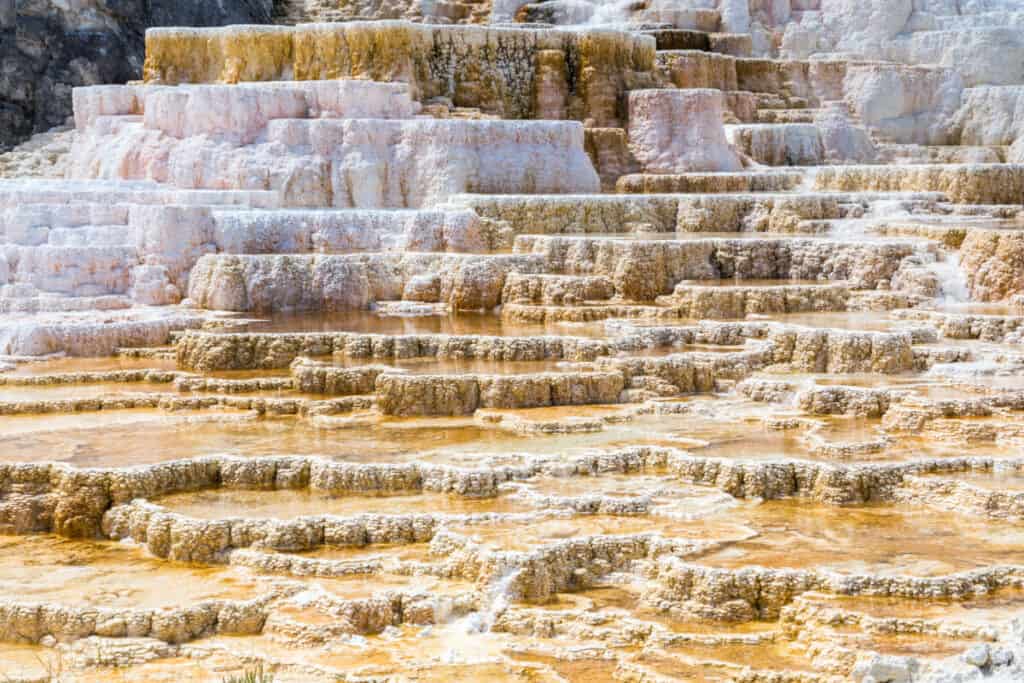
The distinctive inside-out cave aspect of the Mammoth Hot Springs is what makes it so remarkable. Due to Yellowstone’s location in a volcanic hotspot, extremely hot water flows beneath the surface.
The water in this area dissolves the porous limestone and pushes the resulting mixture above ground, where it “cools” and forms the travertine terraces you see.
This one-of-a-kind hydrothermal phenomenon can only be found in Mammoth Hot Springs, and it’s well worth the trip even if you’re staying elsewhere in the park!
Calcite Spring Overlook
Calcite Spring Overlook is one of Yellowstone National Park’s greatest assets. At the narrowest section of the Grand Canyon of Yellowstone, the overlook offers stunning northward views.
The combination of white-bleached cliffs, magnificent lush forest, the thundering Yellowstone River, and distant mountains creates one of Yellowstone’s greatest views.
The best thing about the Calcite Springs Overlook is that it needs very little effort, making it ideal for individuals who are exhausted from lengthy trips or jet lag. Calcite Springs Overlook simply cannot be much better! There is no hiking, no bears, and no fear of your children becoming lost.
Morning Glory Pool
The Morning Glory Pool, which is named after the morning glory flower, has remarkable vibrant hues akin to the Grand Prismatic Spring. It is merely a fraction of the size of Morning Glory Pool.
The Morning Glory Pool was previously blue, but it is now green. The source of hot water has been impeded by human activities such as littering in the pool, causing the temperature to drop and the color to shift.
Morning Glory Pool is now one of Yellowstone’s most well-protected hot springs. On the Upper Geyser Basin trail, Morning Glory Pool is a 25-minute walk from Old Faithful.
You might find yourself spending more time than intended on the trail due to the other great geothermal features!
Grand Prismatic Spring
The word “grand” is a good fit for the largest hot spring in the United States and the third-largest in the world. When it comes to these bizarre geothermal structures, though, size isn’t everything.
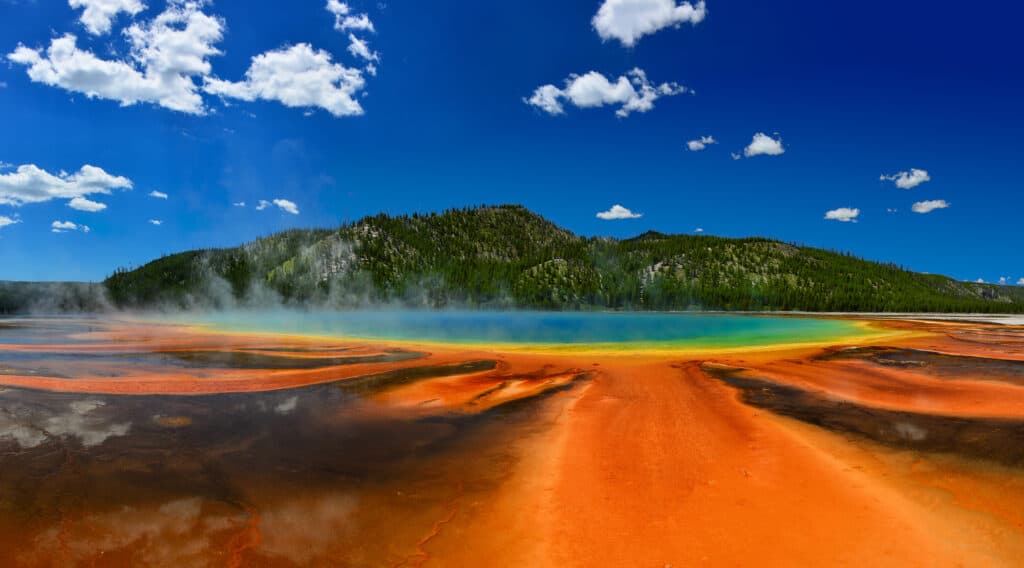
The Grand Prismatic Spring has rainbow-like colors that start in the center and spread out to the spring’s perimeter (thus the term “prismatic”).
Blue predominates in the center, where it is the hottest, but as you approach the hot spring’s edges, it gradually changes to green, yellow, and eventually orange.
The different microorganisms that thrive in such severe temperatures cause this behavior. Because the temperature drops as the spring progress, various colored microorganisms live in different areas.
As one of Yellowstone’s most popular attractions, you should go early in the morning or late in the afternoon to see this celebrity. Otherwise, you can have a difficult time obtaining a parking spot!
Lower Falls
Lower Falls, Yellowstone’s largest and most famous cascade, is the park’s most well-known feature. The trail to the top of the Falls (3/4-mile roundtrip, steep with several switchbacks) is a must, since standing atop the Falls is one of the most breath-taking experiences in the park.
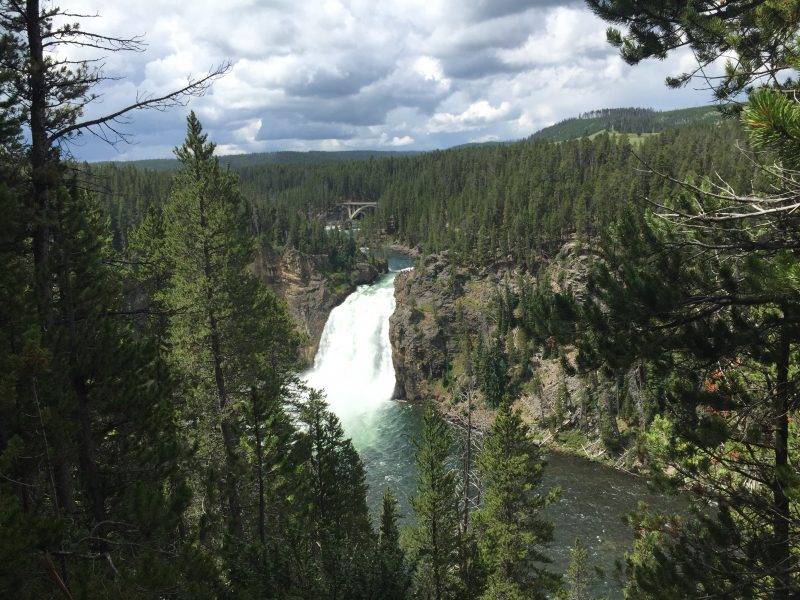
The colors of the canyon were formed by the action of hot water on volcanic rock. The Minnetaree Indians named the river after the river’s yellow banks at its distant confluence with the Missouri River, which French trappers translated as Roche Jaune, yellow stone. More than once, the canyon has been swiftly down cut, possibly by large glacial outburst floods.
The staircase bottoms out around 0.3 miles, bringing you face to face with Lower Yellowstone Falls. Hence, the violent spectacle fascinates and sometimes overwhelms from this close vantage point. A rainbow also persists in the mist near the base of the falls.
Keep in mind that you will most likely not be alone when you descend the staircase. It can be nerve-wracking to share a metal stairway on a cliffside with dozens of other climbers, so be patient and be kind to make the experience as enjoyable as possible for yourself and those around you.
Mud Volcano
The Mud Volcano geothermal area is close to Hayden Valley, making it perfect for anyone looking for some spooky geothermal action after seeing some wildlife.
Mud volcanoes aren’t towering monsters spewing mud at everyone who dares to approach them, despite their name. Mud volcanoes are muddy pits that resemble a witch’s cauldron. The science behind these mud volcanoes, on the other hand, is astounding.
The mud slurry you see is the result of hot water beneath the ground surface mixing with other mineral deposits. Scientists can learn more about what’s going on beneath the surface by attentively studying these mud volcanoes.
The Dragon’s Mouth Spring, a cave formed by erosion from the hot muddy water beneath, is the most famous mud volcano in the area. This tunnel holds steam and pressurizes the mud, even more, resulting in a deafening roar as though a dragon lives inside!
Kayak Day Paddle
A 6-hour kayak excursion with a knowledgeable guide allows you to see Yellowstone Lake’s craggy shoreline and tranquil seas.
Explore the rugged shoreline for natural creatures like elk, moose, and bison; watch otters play in the warm waters of the lake; eat a delicious picnic lunch, and kayak across the West Thumb Geyser Basin to see stunning geothermic features.
The professional guides will provide skilled kayak training as well as knowledge of local history and geology as they take you along the shoreline to the West Thumb Geyser Basin and explore the many geothermal sites on land and underwater.
You’ll paddle through some of the more remote locations, the bulk of which are inaccessible by land and lack signs, boardwalks, and, most importantly, other people.
Since no prior kayaking experience is required, each trip has a limited number of spots, so sign up as soon as possible.
Old Faithful Inn
The Old Faithful Inn is one of Yellowstone National Park’s nine lodges. Old Faithful Inn, the world’s largest log structure, has a rustic yet lovely decor that is appropriate for the old American Midwest.
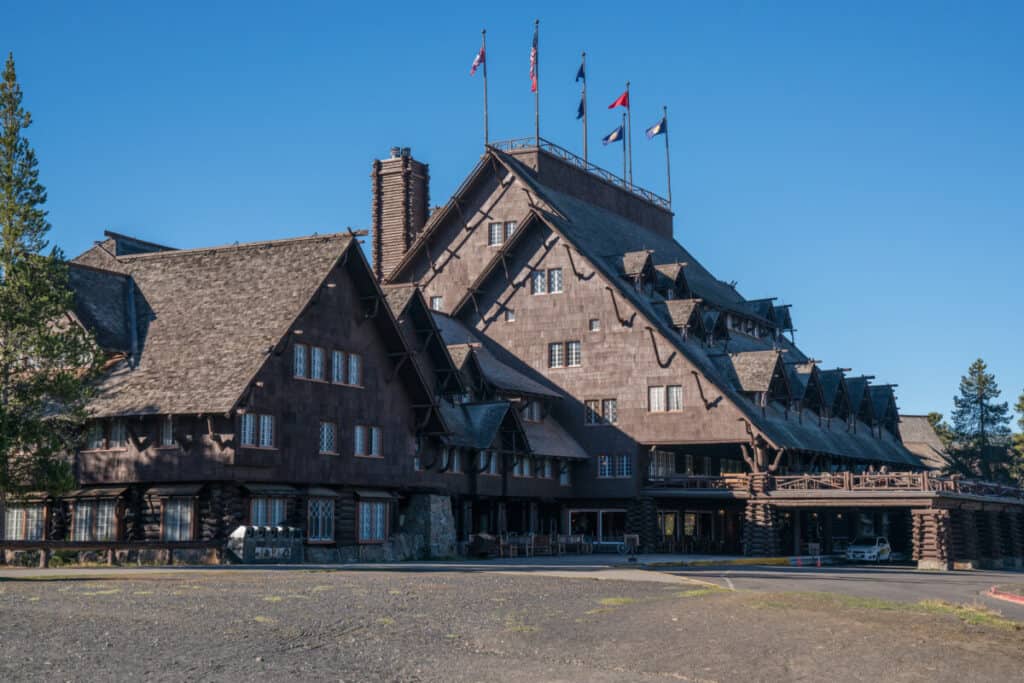
This national historic monument was the first hotel inside Yellowstone National Park, having opened in 1904. It is well worth a visit even if you are not staying there.
You might not be able to stay in one of their rooms because it is the most sought-after hotel inside Yellowstone National Park. In most cases, you’ll need to book at least 6 months ahead of time, especially during the high summer season.
It is allowed for visitors to simply roam around and appreciate the rustic resort architecture. Its 76-foot-high lobby will make you marvel at how they managed to construct such a large structure out of logs in the early 1900s!
All guests can take advantage of free guided tours.
Old Faithful Geyser
Old Faithful, which erupts every 60 to 90 minutes, earned its storied name by being one of the park’s most consistent geysers. Old Faithful’s eruption, which reaches a height of around 185 feet, will astound you.
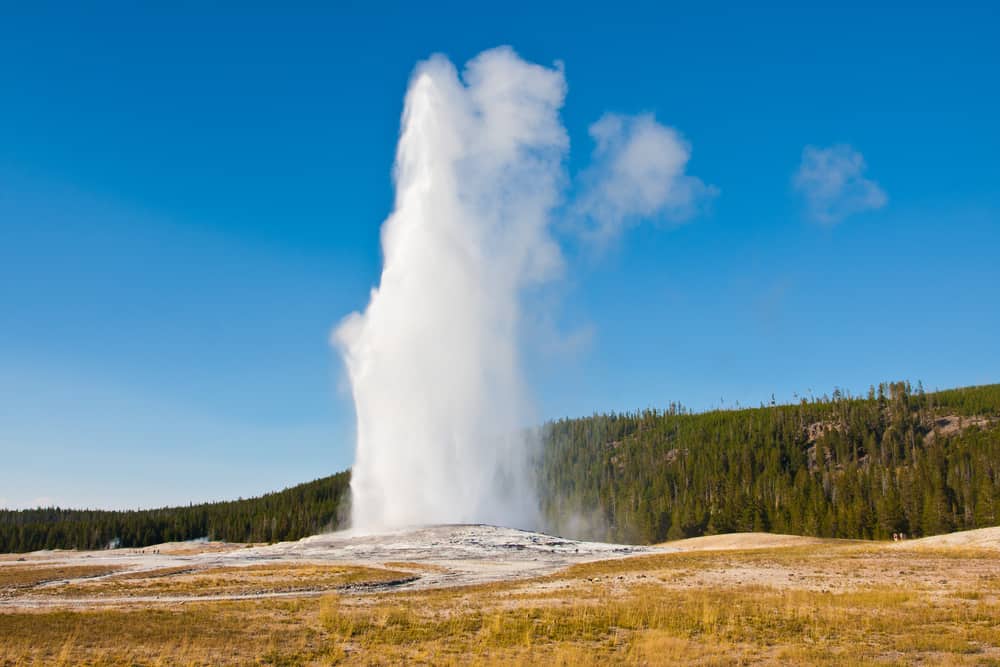
Due to the sheer short time between eruptions, there isn’t much pressure to build up underground. As a result, Old Faithful isn’t even close to being one of the world’s highest geysers. It takes pride in being one of Yellowstone’s largest regular geysers.
The Steamboat Geyser, located in the Norris Geyser Basin, is Yellowstone’s (and the world’s) tallest active geyser. However, due to the unpredictable nature of its eruptions, it is hard to organize your Yellowstone trip around them.
Before visiting Old Faithful, stop at the nearby Old Faithful Visitor and Education Center, where you’ll find information on the science behind the event you’re about to experience, as well as the predicted eruption times of many of the park’s geysers.
Great Fountain Geyser
The Great Fountain Geyser’s total area is likewise vast, which you’ll find rather remarkable for a geyser.
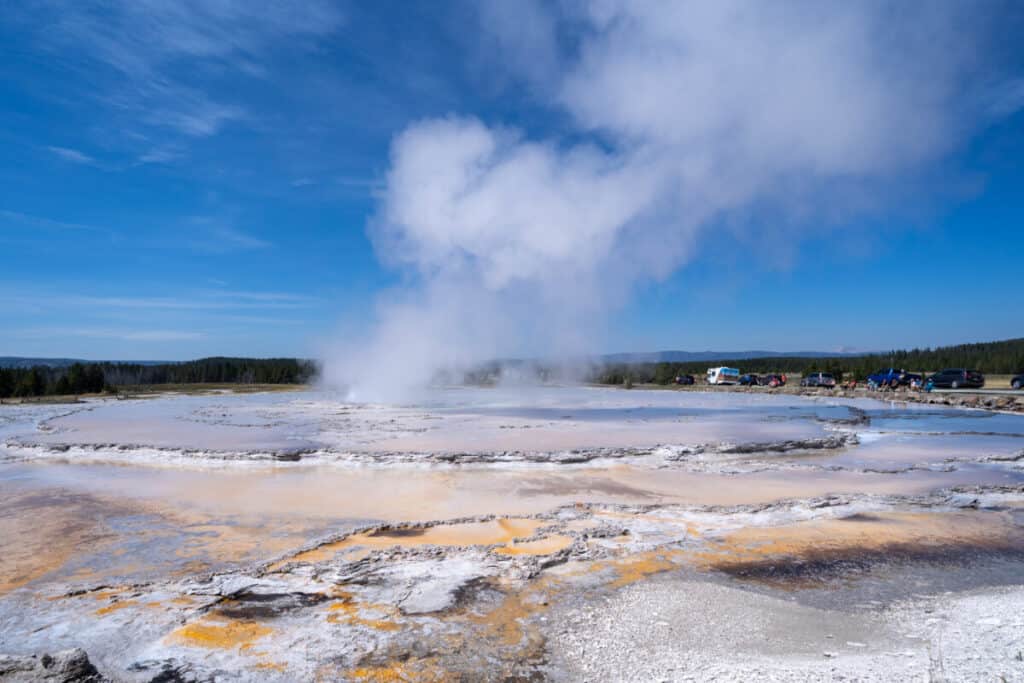
It’s located in the Lower Geyser Basin, and it’s the ideal spot to unwind, eat a snack (or pack a picnic), and watch mother nature unfold right in front of your eyes!
You must visit one of Yellowstone’s visitor centers to learn when the Great Fountain Geyser erupts. There’s a monitor there that shows the expected eruption time for many of the park’s geysers, including the Great Fountain Geyser, Old Faithful, and others.
Wildlife Viewing
The early bird gets the worm, as the saying goes. Visitors to Yellowstone National Park who want to witness wildlife will find this to be true. To increase your chances of spotting wildlife, set your alarms and visit the park early in the morning when animals are eating and moving.
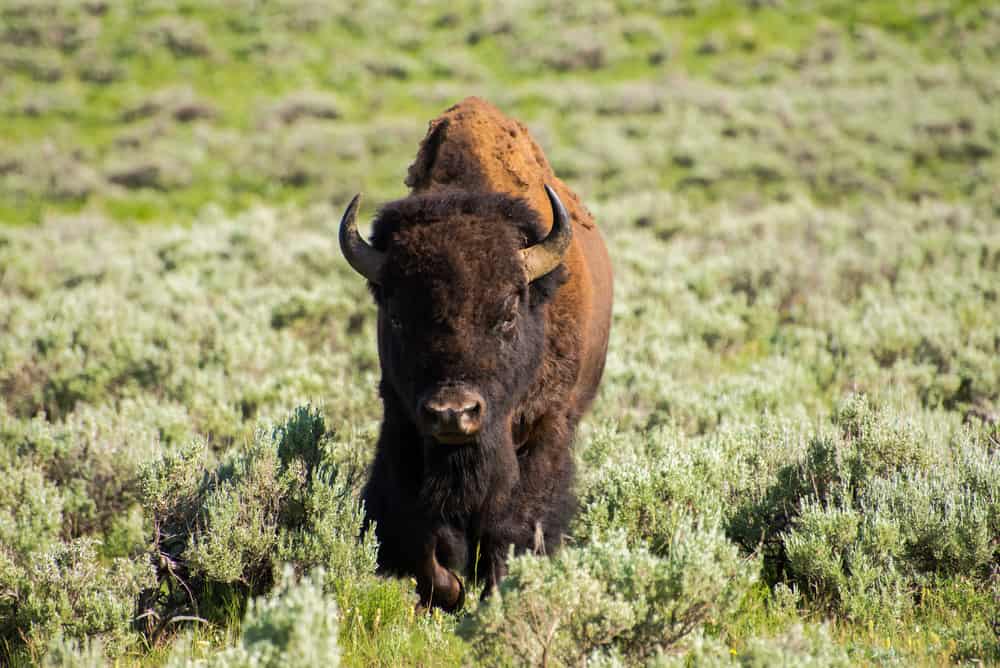
One of the best months to see animals in June. Bears emerge from hibernation later in the summer and rarely travel to higher elevations. You’ll have a good chance of seeing a grizzly off in the distance if you travel to Lamar Valley or Hayden Valley around dawn or twilight. You might spot one near to the road if you’re lucky.
Bison are almost certain to appear, and you’ll almost certainly have to come to a halt to let them cross the road. Although elk and moose do not have antlers at this time of year, they are nonetheless often seen. Wolves are unpredictable, although they have been seen hunting in Lamar Valley this time of year.
Grand Canyon of Yellowstone
See Yellowstone’s most famous waterfalls, the Upper and Lower Falls, on this guided hike with a naturalist guide.
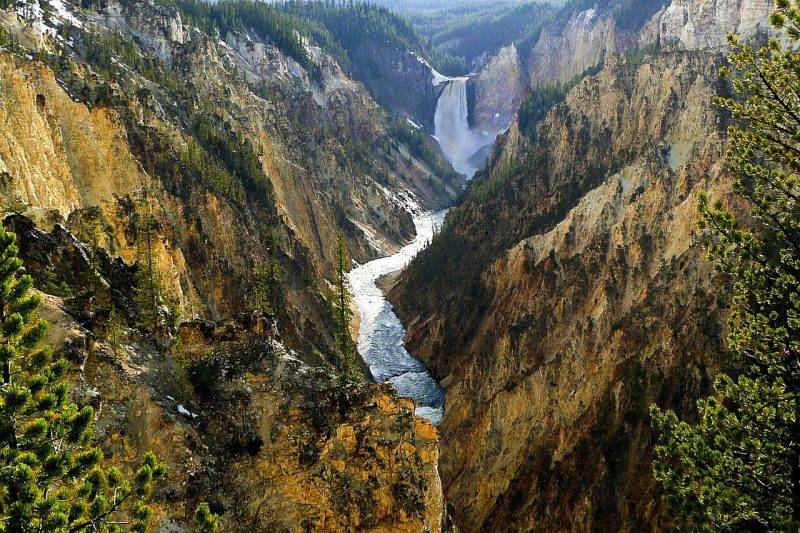
You’ll get a taste of Yellowstone’s remarkable natural magnificence as you see thermals, lakes, and valleys. Hike on less-traveled trails around the rim of a beautiful canyon for a very unique natural experience.
Hike to Artist Point for a beautiful view of the Lower Falls of the Yellowstone River. The most famous waterfall in Yellowstone, which drops over 300 feet, is a sight to behold. Continue going through the endless pines of Yellowstone, past a thermal area with mud pots and steam vents, and along Native trails.
Gear up with packs, hiking poles, binoculars, and bear spray while enjoying a morning snack and warming beverage of coffee, tea, or cocoa. After a quick safety lesson, proceed for a stroll around the rim of the Grand Canyon of the Yellowstone River.
Montana Whitewater Rafting – Gardiner Base Camp
Located in Gardiner, Montana at the north entrance to Yellowstone National Park, they offer 3 great activities out of the Gardiner outpost – Whitewater and Scenic Rafting, Guided Zipline Ecotours, and Horseback Riding- ideal for families, first-timers, and thrill-seekers alike.
The Gardiner Base Camp has the best amenities in town, making it simple for your family to join together for an unforgettable guided trip. Half-day and full-day activities are also available, as well as discounted multi-activity packages like the popular “Zip & Dip” or “Paddle & Saddle.”
Do you want to know how the river is flowing? Check out our Live Webcam from their back door, which overlooks the Yellowstone River! They’re also right across the street from the Super 8 Motel, so you can park your car and walk to their office.
Recent Posts
15 Tips for Visiting the Grand Canyon in September – 2023 Ultimate Guide
Visiting the Grand Canyon in September is a great time to visit. September is a busy time to visit but the crowds are starting to arrive especially toward the end of the month. I’ve included...
15 Tips for Visiting the Grand Canyon in August – 2023 Ultimate Guide
Visiting the Grand Canyon in August is a great time to visit. August is a busy time to visit but the crowds are starting to arrive especially toward the end of the month. I’ve included all...
